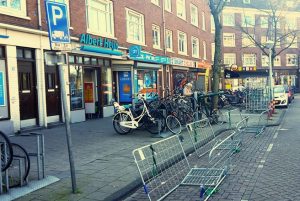BD example: no parking zone
 This situation out the front of my local supermarket caught my attention. Someone who works there, had put grocery racks in the loading zone to block people from parking in those spots. You can see a sign that says it’s a loading zone between 7AM and 1PM. Apparantly, this is not enough and the employees have taken to more extreme measures. They have added behaviour constraints. So what is going on here?
This situation out the front of my local supermarket caught my attention. Someone who works there, had put grocery racks in the loading zone to block people from parking in those spots. You can see a sign that says it’s a loading zone between 7AM and 1PM. Apparantly, this is not enough and the employees have taken to more extreme measures. They have added behaviour constraints. So what is going on here?
There’s a sign, stupid!
For one, the sign is placed in the wrong spot. It violates the first principle of behaviour design; noticability. When you try to park a car, your goal is not to hit anyone or anything. Therefore, your point of view shifts to a circle of about 3 meters around your car, from the ground to approximately 1.7m. The sign is placed parallel to the parking spot, which makes it difficult to see and read when you approach. Also, the sign is so high up, that it is easy to miss for someone sitting down in a car. Changing the position of the sign could make a difference.
Next to that,the sign might also be sending the wrong message. The sign is blue, which signals affordance, instead of red, which is a signal for alert. The sign also shows a truck, therefore it is easy for our brain in a normal car to dismiss the sign as irrelevant. Perhaps if the sign is red and says ‘no parking for passenger cars between 7 and 1’, our brain would notice and process more easily. Adding in feedback (behaviour design principle 4), such as ‘this is a loading zone and you will be towed’ could help people understand why they can’t park and what happens if they do.
Perfect spot!
I think that the design of the actual spot sends mixed messages. People’s main goal here would be to find a parking spot in an area where these are scarce. Their mind is focused on finding an open place that looks like a parking spot. A place that ‘affords’ them to park. Our brain will treat most other input as noise and ignore it.
This open spot, right in front of the supermarket, would catch a driver’s attention.
By making the spot look different from a normal parking spot, for example by changing the colour of the ground, we can alert the brain and tell it that it is not a parking spot. This applies the second and third principle of behaviour design: relevance and logic. You appeal to the direct goals and the mental model of the driver.
All in all, the people of the supermarket have intuitively used the principles of behaviour design to influence the situation. I assume though, that this ‘design intervention’ will be a cause of frustration for both staff and drivers. Perhaps changing the design could improve parking behaviour.

Leave a Reply